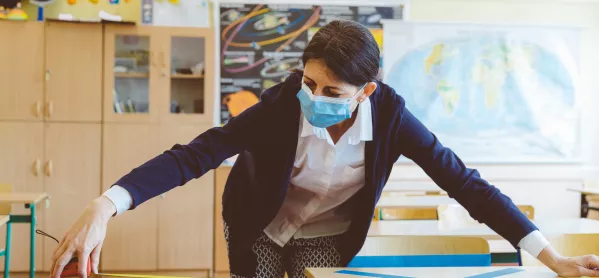- Home
- Social distancing ‘impossible’ with many pupils
Social distancing ‘impossible’ with many pupils

A new survey of over 26,000 teachers reveals that many fear it is impossible to apply social distancing with younger pupils and those who have complex additional needs.
The survey also shows the long hours school staff have been working and the many new skills they have had to develop - as well as the pupils they believe are being left behind by online learning.
Initial findings from the EIS teaching union’s survey of 26,128 school staff were published last week, but now the full results are available.
Coronavirus: The scientific advice on opening Scottish schools
Easing lockdown: Scottish teachers asked what support they need
Opinion: ‘The naivety of teachers’ critics is insulting’
Many teachers say social distancing will be impossible with some children who have additional needs and who are unable to understand the reasons for such measures. Some fear it will also be impossible with younger primary pupils.
The survey found a third of teachers had worked at childcare hubs and that fewer than half (44 per cent) of those had found that social distancing of two metres had been adhered to at all times.
Respondents highlighted that “social distancing measures had been introduced, frequently with clear markings in the room, but that children often struggled to adhere to this, as they naturally moved towards other children and staff, even in small classes”.
One staff member said: “Social distancing measures were put in place in advance (tables spread out, timetable staggered) but especially with pupils of primary school age it was not possible to socially distance. Some needed to have their laces tied repeatedly. In the gym hall, equipment was shared frequently. It’s a Petri dish.”
Another said: “Very difficult to observe social distancing although pupils were clearly trying. Difficult for me as well as the job involves helping children closely with ICT problems or even helping a six-year-old with putting on painting overalls.”
The survey highlights teachers’ concerns about children with additional support needs: only 11 per cent of school staff said children with ASN in their class were having their needs met through online learning.
One teacher said: “It is difficult to get them to engage. The success of working with these children is working closely with them. Not remotely from home.”
Another respondent to the survey of teachers in Scotland said: “Very dyslexic pupils who need a greater amount of support to access written instructions have struggled greatly to engage particularly where this is combined with social family issues. Children with ADHD [attention deficit hyperactivity disorder] have struggled with the amount of screen time as this can lead to heightened behaviours. In some cases, online learning has been a very positive experience for some of our ASD [autistic spectrum disorder] children and we need to learn from this as we go back to more formal schooling.”
Respondents also pointed out that parents who do not speak English are not able to access activities because they require an interpreter.
On a personal level, teachers talked about the struggle to juggle work and family life - as well as “being constantly messaged by some colleagues at all times of the day” at the same time as the image of “lazy teachers wanting to avoid work” is peddled by elements of the media.
The negative impact of home working on wellbeing that teachers were most likely to highlight was the inability to separate out the working day from personal life.
The survey showed that 34 per cent of teachers had a workspace that was separated from other areas of the home.
However, the EIS found that the vast majority of teachers believed the expectations from their school regarding learning were achievable - although primary teachers were more likely (77.3 per cent) than their secondary colleagues (66 per cent) to say this.
Looking ahead to schools reopening to all pupils in some form, the vast majority of teachers (93 per cent) believed that the most important issue was a need for clarity over how teaching and learning will be delivered in 2020-21.
Keep reading for just £1 per month
You've reached your limit of free articles this month. Subscribe for £1 per month for three months and get:
- Unlimited access to all Tes magazine content
- Exclusive subscriber-only stories
- Award-winning email newsletters



